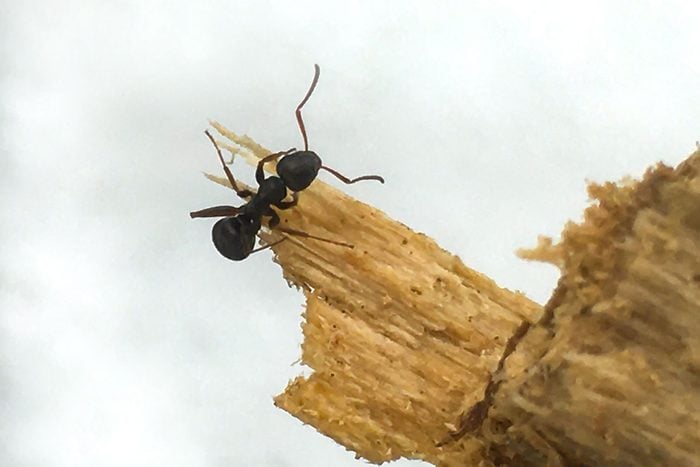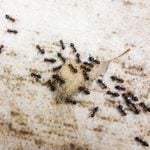How To Identify and Get Rid of Carpenter Ants

Carpenter ants may not eat the wood they chew, but they can still cause a lot of damage to your home. Got carpenter ants? Here's what to know.
On the march to find a moist, cozy place to burrow and build their nests, carpenter ants munch through dead, wet wood easily, creating tunnels and cavities to lay eggs and grow their colonies.
Think you might have a community of carpenter ants in or near your home? Before you panic, here are some facts you should know about these insects.
On This Page
What Is a Carpenter Ant?
Related to bees and wasps, a carpenter ant (sometimes referred to as a flying ant) is a member of the Formicidae family of insects. Carpenter ants live in large colonies with workers, scouts and a queen. They can be found in wooded areas, suburbs and cities. They are one of the largest and most common ant species in the U.S.
To the untrained eye, carpenter ants and termites may look alike, but they are not the same insect.
What Do Carpenter Ants Look Like?
Here’s how to spot the difference between a carpenter ant and a termite:
Carpenter ants
The main identifying characteristics of carpenter ants:
- Measure between 1/2-in. to 5/8-in.;
- Three body segments;
- Narrow waist between the abdomen and thorax;
- Large heads with elbowed (bent) antennae;
- A pair of wings (backs shorter than the fronts);
- Dark red, black, brown or a combination of those colors.
Termites
Termites, on the other hand, are no bigger than a dime and have these features:
- Two body segments;
- Wings of equal length and longer than their body;
- A thick, unpinched waist;
- Straight antennae;
- Light in color or transparent.
What Attracts Carpenter Ants?
The first line of defense against an invading pest is to understand what it likes and doesn’t like. Here are the main things carpenter ants are attracted to:
Soft, wet wood
Carpenter ants adore dead, decaying and moist timber. It’s their reason for living.
Food
Their main source of nutrition is honeydew excreted from aphids they farm. Carpenter ants also feast on the nectar of plants and small insects. Inside homes, they’ll happily eat protein and sugary substances left out on the counters and in garbage pails. In the yard, carpenter ants are drawn to the food in pet bowls and meat juices on barbecue grills.
Damp and dark places
Along with hiding in dewy, decomposing wood, you’ll often find carpenter ants colonizing behind dishwashers and air conditioning units, in the backs of moldy cabinets or around leaky pipes.
What Repels Carpenter Ants?
On the flip side, here is what carpenter ants hate:
Dry conditions
Carpenter ants need a water source to survive and thrive. Eliminating moisture in your home and standing water in the yard is half the battle.
Strong odors
Essential oils like lemongrass, peppermint, clove, cedarwood, tea tree and citrus disrupt their scent trails, leaving them dazed and confused.
Signs of Carpenter Ants In and Around Your House
There are clues to indicate a colony of carpenter ants may be hiding somewhere on your property. Things to watch for include:
- Sawdust, insulation or wood shavings on the ground (extermination pros call it “frass”);
- Visible damage to wood (ruts or groves on the surface);
- Crackling sounds inside walls;
- Dead insect carcasses;
- Shed wings;
- Seeing the ants themselves.
Are Carpenter Ants Dangerous?
While carpenter ants do have a painful bite that can break the skin, they are generally regarded as harmless.
On the other hand, left to their devices, carpenter ants can potentially destroy your home from the inside out. Their chewing action breaks apart decaying logs. If they build a nest in a support beam of a home, it could severely weaken the structure. And just think what they could do if they get their jaws on your wooden deck!
Take it from Ed Spicer, CEO of Pest Strategies: “The carpenter ant is the ant you want to watch out for when it comes to property damage and home destruction.”
How To Get Rid of Carpenter Ants
The best way to rid yourself of carpenter ants is to find the nest and kill the queen. Here are some steps to help you find and destroy a carpenter ant nest indoors and out.
Step 1: Locate the nest. Follow a scent trail or check suspect wood for visible signs of damage, keeping in mind that ants usually forage about 300 feet from the nest. Indoors carpenter ants can often be found nesting near sinks, tubs and other high-moisture zones. Outdoors, check around tree stumps, firewood stacks and wood structures with obvious moisture damage.
Step 2: Destroy the nest. Once you locate a nest indoors, apply insecticide dust by drilling holes into the wall where the nest is suspected and inject the dust. You can also use non-toxic borax, boric acid or diatomaceous earth. You may have to repeat the treatment several times. If the nest is outdoors, drench it with a sprayer of liquid insecticide.
Note: Insecticides can be harmful to children and pets. Follow the label’s instructions carefully.
Step 3: Put out bait. If you can’t find the nest or it is difficult to access, place slow-acting granular bait (tamper-resistant bait stations, if you have children or pets) near entry points and moist areas where ants are likely to gather. You can also spray foam or gel baits into voids, through nail holes into walls, around gaps in plumbing and into ant tunnels themselves. Ants will hopefully bring the bait back to the nest and kill the entire colony, queen and all.
Note: Never spray ants with pesticides. Killing them individually defeats the purpose, because a dead worker or scout can’t bring the bait back to the colony to share with its comrades.
Step 4: If Steps 1, 2 and 3 are unsuccessful, call a pest control expert in your area who specializes in carpenter ant control.
How To Prevent Carpenter Ants From Getting Into Your Home
Carpenter ants are big compared to other ants, but they’re still ants and therefore can easily enter your home through frame joints, cracks in the foundation or gaps under doors. To avoid the hassle and expense of eliminating an infestation of carpenter ants, take the following steps to discourage them from building a nest in or around your home.
- Keep food in airtight containers and clean up spills and crumbs;
- Seal cracks and holes;
- Trim vegetation back from the house;
- Remove rotted or infested wood;
- Raise firewood off the ground;
- Spray a chemical or non-toxic insecticide barrier around your home.




